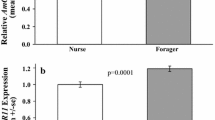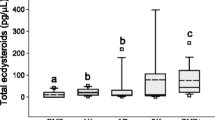Abstract
Using a computer-controlled pheromone-puff delivery system with signal averaging, we investigated the change with age of the electroantennogram (EAG) response of drone (male) honey bees to queen mandibular pheromone (QMP) and an alarm pheromone component, isopentyl acetate (IPA). Drone antennae were significantly more sensitive than worker antennae to QMP, but there was no significant difference in response to IPA. Response to QMP was dose dependent and decreased gradually with the age of the drone. Drone response to IPA did not diminish significantly with age. Drones do not mature sexually or make their first flights until about 1 week old, so the ontogeny of their sensory responsiveness to queen pheromones does not reflect that of their behavior. It is unknown if drones exhibit any behavioral response to IPA. The signal-averaging system we describe could be used to improve resolution of low signal-to-noise ratio signals in other EAG studies.
Similar content being viewed by others
REFERENCES
ADLER, V. E., DOOLITTLE, R. E., SHIMANUKI, H., and JACOBSON, M. 1973. Electrophysiological screening of queen substance and analogs for attraction to drone, queen and worker honey bees. J. Econ. Entomol. 66:33–36.
ALLAN, S. A., SLESSOR, K. N., WINSTON, M. L., and KING, G. G. S. 1987. The influence of age and task specialization on the production and perception of honey bee pheromones. J. Insect Physiol. 33:917–922.
ARNOLD, G., MASSON, C., and BUDHARUGSA, S. 1983. Organisation spatiale du systéme nerveux antennaire de l'abeille étudiée au moyen d'une technique de marquage aux ions cobalt. Apidologie 14:127–135 (English summary).
BJOSTADT, L. B., and ROELOFS, W. L. 1980. An inexpensive electronic device for measuring electroantennogram responses to sex pheromones with a voltmeter. Physiol. Entomol. 5:309–314.
BLANEY, W. M., SCHOONHOVEN, L. M., and SIMMONDS, M. S. J. 1986. Sensitivity variations in insect chemoreceptors; A review. Experientia 42:13–19.
GRANT, G. G., BRADY, U. E., and BRAND, J. M. 1972. Male armyworm scent brush secretion: Identification and electroantennogram study of major components. Ann. Entomol. Soc. Am. 65:1224–1227.
HENNING, J. A., and TEUBER, L. R. 1992. Combined gas chromatography-electroantennogram characterization of alfalfa floral volatiles recognized by honey bees (Hymenoptera: Apidae). J. Econ. Entomol. 85:226–232.
HOWELL, D. E., and USINGER, R. L. 1933. Observations on the flight and length of life of drone bees. Ann. Entomol. Soc. Am. 26:239–246.
JAYCOX, E. R. 1956. Factors affecting the attainment of sexual maturity by the drone honeybee (Apis mellifera L.) PhD dissertation. University of California, Davis, California.
KAISSLING, K-E., and RENNER, M. 1968. Antennale Rezeptoren für Queen Substance und Sterzelduft bei der Honigbeine. Z. Vergl. Physiol. 59:357–361.
LACHER, V. 1964. Elektrophysiologische Untersuchungen an einzelnen Rezeptoren für Geruch, Kohlendioxyd, Luftfeuchtigkeit und Temperatur auf den Antennen der Arbeitsbiene und der Drohne (Apis mellifera L.) Z. Vergl. Physiol. 48:587–623.
LOPER, G. M. 1993. What do we really know about drone flight behavior? Bee World 73:198–203.
MASSON, C., and ARNOLD, G. 1984. Ontogeny, maturation and plasticity of the olfactory system in the workerbee. J. Insect Physiol. 30:7–14.
MORSE, R. A., STRANG, G. E., and NOWAKOWSKI, J. 1967. Fall death rates of drone honey bees. J. Econ. Entomol. 60:1198–1202.
OERTEL, E. 1956. Observations on the flight of drone honey bees. Ann. Entomol. Soc. Am. 49:497–500.
PAYNE, T. L., SHOREY, H. H., and GASTON, L. K. 1970. Sex pheromones of noctuid moths: Factors influencing antennal responsiveness in males of Trichoplusia ni. J. Insect Physiol. 16:1043–1055.
PATTE, F. M., ETCHETO, M., MARFAING, P., and LAFFORT, P. 1989. Electroantennogram stimulus-response curves for 59 odourants in the honey bee, Apis mellifera. J. Insect Physiol. 35:667–675.
PHAM-DELÈGUE, M. H., MASSON, C., ETIEVANT, P., and AZAR, M. 1986. Selective olfactory choices of the honeybee among sunflower aromas: A study by combined olfactory conditioning and chemical analysis. J. Chem. Ecol. 12:781–793.
PHAM-DELÈGUE, M. H., ETIEVANT, P., GUICHARD, E., and MASSON, C. 1989. Sunflower volatiles involved in honey bee discrimination among genotypes and flowering stages. J. Chem. Ecol. 15:329–343.
PHAM-DELÈGUE, M. H., ETIEVANT, P., GUICHARD, E., MARILLEAU, R., DOUAULT, P., CHAUFFAILLE, J., and MASSON, C. 1990. Chemicals involved in honey bee-sunflower relationship. J. Chem. Ecol. 16:3053–3065.
PHAM-DELÈGUE, M. H., TROUILLER, J., CAILLAUD, C. M., ROGER, R., and MASSON, C. 1993. Effect of queen pheromone on worker bees of different ages: Behavioural and electrophysiological responses. Apidologie 24:267–281.
ROBINSON, G. E. 1987. Modulation of alarm pheromone perception in the honey bee: Evidence for division of labor based on hormonally regulated response thresholds. J. Comp. Physiol. 160:613–619.
ROSS, R. J., PALANISWAMY, P., and SEABROOK, W. D. 1979. Electroantennograms from spruce budworm moths (Choristoneura fumiferana) (Lepidoptera: Tortricidae) of different ages and for various pheromone concentrations. Can. Entomol. 111:807–816.
RUTTNER, F. 1966. The life and flight activity of drones. Bee World 47:93–100.
RUTTNER, H., and RUTTNER, F. 1972. Untersuchungen über die Flugaktivität und das Paarungsverhalten der Drohnen. V. Drohnensammelplätze und Paarungsdistanz. Apidologie 3:203–232.
SEABROOK, W. D., HIRAI, K., SHOREY, H. H., and GASTON, L. K. 1979. Maturation and senescence of an insect chemosensory response. J. Chem. Ecol. 5:587–594.
SLESSOR, K. N., KAMINSKI, L. A., KING, G. G. S., BORDEN, J. H., and WINSTON, M. L. 1988. Semiochemical basis of the retinue response to queen honey bees. Nature 332:354–356.
THIERY, D., BLUET, J. M., PHAM-DELÈGUE, M. H., ETIEVANT, P., and MASSON, C. 1990. Sunflower aroma detection by the honey bee study by coupling gas chromatography and electroantennography. J. Chem. Ecol. 16:701–711.
TURGEON, J. J., MC NEIL, J. N., and ROELOFS, W. L. 1983. Responsiveness of Pseudaletia unipuncta males to the female sex pheromone. Physiol. Entomol. 8:339–344.
VISSCHER, P. K., VETTER, R. S. and ROBINSON, G. E. 1995. Alarm pheromone perception in honey bees is decreased by smoke (Hymenoptera: Apidae). J. Insect Behav. 8:11–18.
WINSTON, M. L. 1987. The Biology of the Honey Bee. Harvard University Press, Cambridge, Massachusetts.
WINSTON, M. L., and SLESSOR, K. N. 1993. Applications of queen honey bee mandibular perhomone for beekeeping and crop pollination. Bee World 73:111–128.
WITHERALL, P. C. 1971. Duration of flight and of interflight time of drone honey bees, Apis mellifera. Ann. Entomol. Soc. Am. 64:609–612.
WOYKE, J., and JASINSKI, Z. 1978. Influence of age of drone on the results of instrumental insemination of honeybee queens. Apidologie 9:203–212.
Author information
Authors and Affiliations
Rights and permissions
About this article
Cite this article
Vetter, R.S., Visscher, P.K. Influence of Age on Antennal Response of Male Honey Bees, Apis mellifera, to Queen Mandibular Pheromone and Alarm Pheromone Component. J Chem Ecol 23, 1867–1880 (1997). https://doi.org/10.1023/B:JOEC.0000006456.90528.94
Issue Date:
DOI: https://doi.org/10.1023/B:JOEC.0000006456.90528.94




